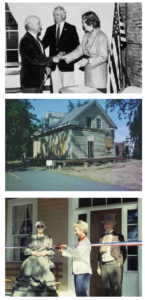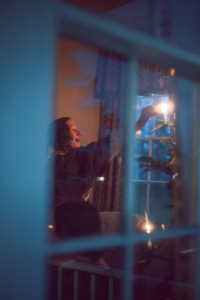Opinion: Fort Steilacoom deserves a landlord whose mission embraces history
The following is based on an opinion column from our board president, Walter Neary, printed in the summer 2023 journal for HFSA members:
This has been a historic year for Fort Steilacoom, as we make plans for a brighter future. I’m very proud of our current board for recognizing the truth of a famous quote: The definition of insanity is doing the same thing over and over and expecting a different result.
This quote occurred to me a couple years ago, when I had the pleasure of returning after exactly 20 years as president of the board of Historic Fort Steilacoom.
What I saw is the challenges we faced in 2021 were the same challenges we faced in 2001.
- Too few volunteers.
- Too little public unawareness that the U.S. Army fort that claimed Seattle and the rest of Puget Sound for the United States is in Lakewood.
- Too little money for maintenance or educational programs.
- No paid staff.
- Buildings slowly or even quickly suffering water or other damage for lack of investment.
- No volunteer coordinator.
- Someone looking at the board president, or the secretary, or you name the person, like they’re the one who should accomplish things.
I could go on. You get the idea. When I joined the board in 2021, we had the same idea we had in 2001: That the problem was us, to paraphrase Taylor Swift.
- If only we could hold more tours, that would solve the problem!
- If only we spiffed up our newsletter, that would solve the problem!
- If only we rejiggered something, we’d make up for the fact that Fort Steilacoom’s budget is 1.3 percent of the nearest fort museum.
Our current board has embraced a new way of thinking—the problem is Washington.
Washington is the only state in the nation that has put its most historic buildings – ‘first fort’ under the management of a mental hospital and social services agency.
Washington is the only state in the nation that asks a band of volunteers to pay for, maintain, and interpret the complex stories of a first U.S. Army fort. We’ve begun to involve Tribes through our board to address some challenging questions of interpretation. But we have a long way to go.
Suppose Washington treated its schools the same way it treats Puget Sound’s first fort. I suppose we should be glad Washington didn’t put all the public school lands under the management of DSHS. I mean, that model could save a ton of money.
- Lay off all the school boards, administrators, and teachers. No paid staff.
- Let parents organize the classes that take place on those lands, without tax support.
- That would sure put some stress on parents. But the schools would be all volunteer!
And it’s likely education would suffer. Maybe—education takes expertise and investment. The fact of the matter is, based on what we see in 49 other states, a first fort needs a parent organization that knows something about education.
The search for rational governance begins
We first articulated this perspective in a guest column kindly shared by The News Tribune. Then, advocates for history and champions of clear thinking offered perspectives. Feliks Banel did a thorough look at the subject for KIRO. Knute Berger wrote a supportive note in his newsletter, Mossback.
At the same time, visionaries within the City of Lakewood have recognized what you already know as a member: Fort Steilacoom is an amazing resource. Fort Steilacoom provides:
- Hands-on illustration of the daily life of a pioneer.
- Direct connection to Washington Territory’s political history.
- Direct connection to one of the, if not the most, studied historical events in the history of this nation: the U.S. Civil War.
And you can walk through four buildings configured as they were in 1858. Where else can you do that in Puget Sound? It’s a chance to learn about the daily life of pioneers in buildings that actually witnessed daily life of pioneers.
I remain hopeful the fort finds a landlord with expertise in telling these stories, whether that’s the City of Lakewood, or another parks or museum agency. Fort Steilacoom and its volunteers could do amazing things if we had the same governance found in the other 49 states.
Honoring the current landlord
Before concluding, I want to make a point about Western State and DSHS. In no way, shape, or form, is this initiative a rejection of the many ways they have supported Fort Steilacoom. We’re just looking for an appropriate landlord.
In fact, I think we’re the ones who respect DSHS. Let me explain.
The state of Washington thinks DSHS has nothing better to do than take care of four of the most historic buildings that stand together in Puget Sound.
That’s rather insulting.
That’s like me coming to your workplace while you’re on the job and saying, “Hey, you don’t have anything better to do. Go to Safeway right now and grab me some things!”
I don’t know about you, but I’d be insulted by such a request. My work must be unimportant to you.
To me, this is indicative of how we don’t support mental health care. We, as a state, think so little of mental health care workers that we ask them to do something completely inappropriate: Care for and interpret a historic resource.
The state of Washington, which has responsibility for its own history, is effectively saying, “Eh, whatever, all Western State is doing is mental health care. They have time.”
As someone who has had family members with mental health issues, this makes me angry.
Mental health care is a full time job. DSHS has enough to do, and meanwhile, Fort Steilacoom has stories to tell.
We are thrilled to be on that journey with the members who are supporting the buildings. Thank you for being a member!

 to buildings that they were preserving for us. One photo is of Steilacoom Mayor Lyle Dunkin with then-Secretary of State Ralph Munro and Jean Gardner, wife of the governor at the time.
to buildings that they were preserving for us. One photo is of Steilacoom Mayor Lyle Dunkin with then-Secretary of State Ralph Munro and Jean Gardner, wife of the governor at the time.